#new york times article
Explore tagged Tumblr posts
Text
Sometimes the only thing that keeps me going in this joke of a country is the schadenfreude Trump supporters keep supplying me with.
I like to think of myself as a kind person, and I can be empathetic to a fault sometimes. I would also be totally lying if I said I wasn't thoroughly enjoying seeing all the Trump voters who are finally starting to question whether or not their billionaire daddies Trump and Musk actually have their best interests at heart.
Like right now there's that debate going on about H1B visas; Elon Musk has openly and repeatedly stated his desire to exploit the labor of immigrants because it's so much cheaper than American labor. Trump seems to be backing him up. And everywhere I go Trumpers being like "wow, I had no idea Trump would sell American workers out!!! Very disappointed in him."
Literally how many times does this man have to hit you in the fucking face and spit in your mouth before you finally catch on that he doesn't care about you at all, lmao. I'm genuinely embarrassed for you that you keep putting up with this.
#the comments on a New York Post article about H1B visas is SOOOOOO funny#hundreds of comments from Trumpers crying about how they feel betrayed but are still totally glad Kamala didn't win#it doesn't matter because this is the 12980th time Trump has fucked them over and they'll keep crawling back to him anyway#it's a cult#politics#us politics#h 1b visa#elon musk#fuck elon musk#fuck trump#schadenfreude#leopards ate my face#leopards eating people's faces party
636 notes
·
View notes
Text
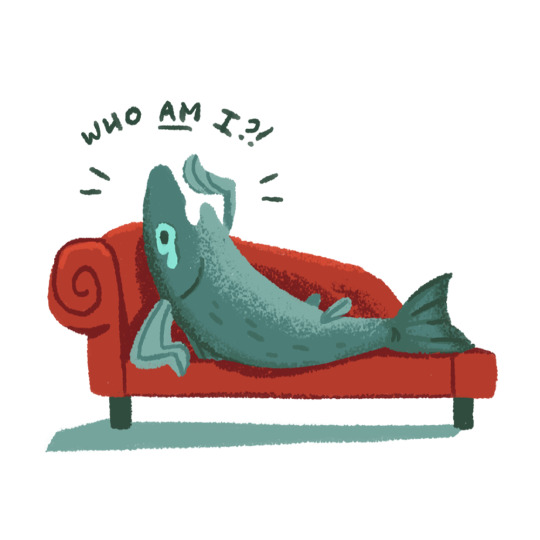
everyone look at this fish i had to draw for my illustration class. for a grade. i am going to get a good grade in therapy salmon, something which is both normal to w
#just did the calculation and this class costs me 8k a semester. btw. money well spent#new york times hire me to do your spot illustrations since i am clearly so fucking good at it. god i hate editorial assigments#skribbles#the worst part is i KNOW im going to go into crit and people r going to be like umm therapy salmon doesnt really fit the vibe of the articl#OK SHUT THE FUCK UP. MAYBE I LIKE DRAWING FISH HAVING MENTAL BREAKDOWNS. HUH. DID YOU EVER THINK OF THAT
2K notes
·
View notes
Text

Taylor Swift's Delirious Eras Tour
#Taylor swift#taylorswift#tswift#tswiftedit#my edits#the eras tour#eras tour#eras tour movie#New York times#nyt#lol why that word?#I didn't read it so Idk if it's a good article or not#just love this pic!#q
607 notes
·
View notes
Text
I know some people were able to attend multiple times and that adds up, but I’m curious to know what the highest price was for a single show. Also put in the tags if you purchased through Ticketmaster or a secondary site, I’m curious to see if the prices varies significantly between the platforms.
#taylor swift#the eras tour#polls#Payton makes polls#I paid close to $400 for my two tickets#I got tickets through Ticketmaster in the pre-sale#this is inspired by the post by the New York Times and their new article
56 notes
·
View notes
Text


#the new york times t is one of those responses where I can't tell if it's a totally glib answer or not.#I completely get where they're coming from. I like A for similar reasons to flansburgh#I also like a w. you might say it's just 2 Us or 2 Vs stuck together#but exactly! it takes their satisfying container shape and doubles it!#tmbg#they might be giants#john linnell#john flansburgh#2000s#interviews#articles
64 notes
·
View notes
Text
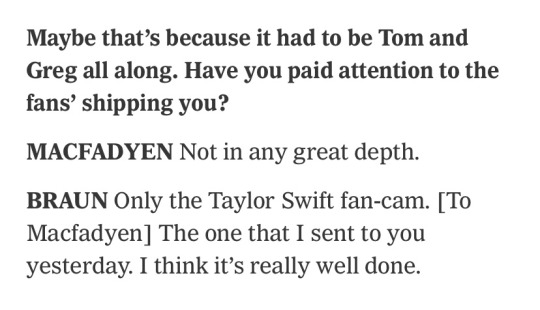
have you guys seen this
#this is a new york times article by the way#i don’t go here but i feel like you all needed to see this#succession#tomgreg#100#greatest hits
1K notes
·
View notes
Text
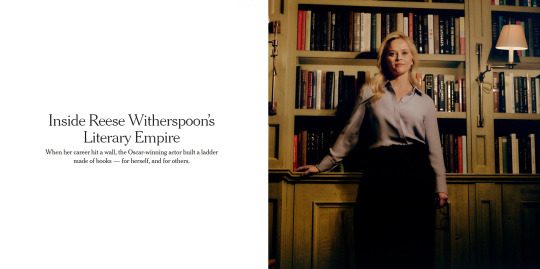
By Elisabeth Egan May 18, 2024
“You’d be shocked by how many books have women chained in basements,” Reese Witherspoon said. “I know it happens in the world. I don’t want to read a book about it.”
Nor does she want to read an academic treatise, or a 700-page novel about a tree.
Sitting in her office in Nashville, occasionally dipping into a box of takeout nachos, Witherspoon talked about what she does like to read — and what she looks for in a selection for Reese’s Book Club, which she referred to in a crisp third person.
“It needs to be optimistic,” Witherspoon said. “It needs to be shareable. Do you close this book and say, ‘I know exactly who I want to give it to?’”
But, first and foremost, she wants books by women, with women at the center of the action who save themselves. “Because that’s what women do,” she said. “No one’s coming to save us.”
Witherspoon, 48, has now been a presence in the book world for a decade. Her productions of novels like “Big Little Lies,” “Little Fires Everywhere” and “The Last Thing He Told Me” are foundations of the binge-watching canon. Her book club picks reliably land on the best-seller list for weeks, months or, in the case of “Where the Crawdads Sing,” years. In 2023, print sales for the club’s selections outpaced those of Oprah’s Book Club and Read With Jenna, according to Circana Bookscan, adding up to 2.3 million copies sold.
So how did an actor who dropped out of college (fine, Stanford) become one of the most influential people in an industry known for being intractable and slightly tweedy?
It started with Witherspoon’s frustration over the film industry’s skimpy representation of women onscreen — especially seasoned, strong, smart, brave, mysterious, complicated and, yes, dangerous women.
“When I was about 34, I stopped reading interesting scripts,” she said.
Witherspoon had already made a name for herself with “Election,” “Legally Blonde” and “Walk the Line.” But, by 2010, Hollywood was in flux: Streaming services were gaining traction. DVDs were following VHS tapes to the land of forgotten technology.
“When there’s a big economic shift in the media business, it’s not the superhero movies or independent films we lose out on,” Witherspoon said. “It’s the middle, which is usually where women live. The family drama. The romantic comedy. So I decided to fund a company to make those kinds of movies.”
In 2012, she started the production company Pacific Standard with Bruna Papandrea. Its first projects were film adaptations of books: “Gone Girl” and “Wild,” which both opened in theaters in 2014.
Growing up in Nashville, Witherspoon knew the value of a library card. She caught the bug early, she said, from her grandmother, Dorothea Draper Witherspoon, who taught first grade and devoured Danielle Steel novels in a “big cozy lounger” while sipping iced tea from a glass “with a little paper towel wrapped around it.”
This attention to detail is a smoke signal of sorts: Witherspoon is a person of words.
When she was in high school, Witherspoon stayed after class to badger her English teacher — Margaret Renkl, now a contributing opinion writer for The New York Times — about books that weren’t part of the curriculum. When Witherspoon first moved to Los Angeles, books helped prepare her for the “chaos” of filmmaking; “The Making of the African Queen” by Katharine Hepburn was a particular favorite.
So it made sense that, as soon as Witherspoon joined Instagram, she started sharing book recommendations. Authors were tickled and readers shopped accordingly. In 2017, Witherspoon made it official: Reese’s Book Club became a part of her new company, Hello Sunshine.
The timing was fortuitous, according to Pamela Dorman, senior vice president and publisher of Pamela Dorman Books/Viking, who edited the club’s inaugural pick, “Eleanor Oliphant is Completely Fine.” “The book world needed something to help boost sales in a new way,” she said.
Reese’s Book Club was that something: “Eleanor Oliphant” spent 85 weeks on the paperback best-seller list. The club’s second pick, “The Alice Network,” spent nearly four months on the weekly best-seller lists and two months on the audio list. Its third, “The Lying Game,” spent 18 weeks on the weekly lists.
“There’s nothing better than getting that phone call,” added Dorman, who has now edited two more Reese’s Book Club selections.
Kiley Reid’s debut novel, “Such a Fun Age,” got the nod in January 2020. She said, “When I was on book tour, a lot of women would tell me, ‘I haven’t read a book in four years, but I trust Reese.’” Four years later, on tour for her second novel, “Come and Get It,” Reid met women who were reading 100 books a year.
Witherspoon tapped into a sweet spot between literary and commercial fiction, with a few essay collections and memoirs sprinkled in. She turned out to be the literary equivalent of a fit model — a reliable bellwether for readers in search of intelligent, discussion-worthy fare, hold the Proust. She wanted to help narrow down the choices for busy readers, she said, “to bring the book club out of your grandma’s living room and online.”
She added: “The unexpected piece of it all was the economic impact on these authors’ lives.”
One writer became the first person in her family to own a home. “She texted me a picture of the key,” Witherspoon said. “I burst into tears.”
Witherspoon considers a handful of books each month. Submissions from publishers are culled by a small group that includes Sarah Harden, chief executive of Hello Sunshine; Gretchen Schreiber, manager of books (her original title was “bookworm”); and Jon Baker, whose team at Baker Literary Scouting scours the market for promising manuscripts.
Not only is Witherspoon focused on stories by women — “the Bechdel test writ large,” Baker said — but also, “Nothing makes her happier than getting something out in the world that you might not see otherwise.”
When transgender rights were in the headlines in 2018, the club chose “This Is How It Always Is,” Laurie Frankel’s novel about a family grappling with related issues in the petri dish of their own home. “We track the long tail of our book club picks and this one, without fail, continues to sell,” Baker said.
Witherspoon’s early readers look for a balance of voices, backgrounds and experiences. They also pay attention to the calendar. “Everyone knows December and May are the busiest months for women,” Harden said, referring to the mad rush of the holidays and the end of the school year. “You don’t want to read a literary doorstop then. What do you want to read on summer break? What do you want to read in January?”
Occasionally the group chooses a book that isn’t brand-new, as with the club’s April pick, “The Most Fun We Ever Had,” from 2019. When Claire Lombardo learned that her almost-five-year-old novel had been anointed, she thought there had been a mistake; after all, her new book, “Same As it Ever Was,” is coming out next month. “It’s wild,” Lombardo said. “It’s not something that I was expecting.”
Sales of “The Most Fun We Ever Had” increased by 10,000 percent after the announcement, according to Doubleday. Within the first two weeks, 27,000 copies were sold. The book has been optioned by Hello Sunshine.
Witherspoon preferred not to elaborate on a few subjects: competition with other top-shelf book clubs (“We try not to pick the same books”); the lone author who declined to be part of hers (“I have a lot of respect for her clarity”); and the 2025 book she’s already called dibs on (“You can’t imagine that Edith Wharton or Graham Greene didn’t write it”).
But she was eager to set the record straight on two fronts. Her team doesn’t get the rights to every book — “It’s just how the cookie crumbles,” she said — and, Reese’s Book Club doesn’t make money off sales of its picks. Earnings come from brand collaborations and affiliate revenue.
This is true of all celebrity book clubs. An endorsement from one of them is a free shot of publicity, but one might argue that Reese’s Book Club does a bit more for its books and authors than most. Not only does it promote each book from hardcover to paperback, it supports authors in subsequent phases of their careers.
Take Reid, for instance. More than three years after Reese’s Book Club picked her first novel, it hosted a cover reveal for “Come and Get It,” which came out in January. This isn’t the same as a yellow seal on the cover, but it’s still a spotlight with the potential to be seen by the club’s 2.9 million Instagram followers.
“I definitely felt like I was joining a very large community,” Reid said.
“Alum” writers tend to stay connected with one another via social media, swapping woot woots and advice. They’re also invited to participate in Hello Sunshine events and Lit Up, a mentorship program for underrepresented writers. Participants get editing and coaching from Reese’s Book Club authors, plus a marketing commitment from the club when their manuscripts are submitted to agents and editors.
“I describe publishing and where we sit in terms of being on a river,” Schreiber said. “We’re downstream; we’re looking at what they’re picking. Lit Up gave us the ability to look upstream and say, ‘We’d like to make a change here.’”
The first Lit Up-incubated novel, “Time and Time Again” by Chatham Greenfield, is coming out from Bloomsbury YA in July. Five more fellows have announced the sales of their books.
As Reese’s Book Club approaches a milestone — the 100th pick, to be announced in September — it continues to adapt to changes in the market. Print sales for club selections peaked at five million in 2020, and they’ve softened since then, according to Circana Bookscan. In 2021, Candle Media, a Blackstone-backed media company, bought Hello Sunshine for $900 million. Witherspoon is a member of Candle Media’s board. She is currently co-producing a “Legally Blonde” prequel series for Amazon Prime Video.
This month, Reese’s Book Club will unveil an exclusive audio partnership with Apple, allowing readers to find all the picks in one place on the Apple Books app. “I want people to stop saying, ‘I didn’t really read it, I just listened,’” Witherspoon said. “Stop that. If you listened, you read it. There’s no right way to absorb a book.”
She feels that Hollywood has changed over the years: “Consumers are more discerning about wanting to hear stories that are generated by a woman.”
Even as she’s looking forward, Witherspoon remembers her grandmother, the one who set her on this path.
“Somebody came up to me at the gym the other day and he said” — here she put on a gentle Southern drawl — “‘I’m going to tell you something I bet you didn’t hear today.’ And he goes, ‘Your grandma taught me how to read.’”
Another smoke signal, and a reminder of what lives on.
#reese witherspoon#reese's book club#reading#literary#club#book#new york times#elisabeth egan#article
197 notes
·
View notes
Text

july 18, 2023 | one year ago today
the new york times released an article about kaylor titled, “A Celebrity Lesbian Romance Changed My Life. (Even if It Never Happened.)”
honorable mention to this comment

#july 18 2023#july 18#2023#karlie kloss#kaylor#new york times#articles#gaylor throwbacks#gaylor#gaylor swift#lgbetty
141 notes
·
View notes
Text

I'm always a fan of Caity Weaver's work, but this piece from the New York Times Magazine (these links are gift links from me past the NYT paywall to access the full article) about how the penny is not only a ridiculous zombie currency, but also a reflection of American dysfunction is one of the best articles I've read in a long time. It's really interesting, especially the parts about production, circulation, and the ultimate paralysis of throwing them in a coin jar for months or years before eventually taking them to a Coinstar machine.
Not only is the penny useless and more expensive to make than it is actually worth, but it's also relatively easy to eliminate. But it's not an imperative and eliminating it also wouldn't necessarily be something that the government or the citizens would actively profit from. And people don't like change -- and I don't mean "change" as in currency, but the act of doing something different or unusual from our accepted routines. So we just ignore them or discard them or hoard them needlessly, and the government keeps making billions of tons (literally) of them because they drop out of circulation. Nobody cares and nobody wants to have to do anything about it because America.
Here's a little excerpt of the piece from the New York Times Magazine, and again, just follow the links for a free gift pass behind the paywall for Caity's full article:
Americans accumulate pennies not because we desire them but because we are entitled to them. If we pay for something in cash with more than exact change, we expect to receive back the difference; if the difference ends in any number other than 0 or 5, we will receive at least one penny. We are entitled to pennies because they exist. But imagine a world where they didn't. Imagine a world where it was Canada. Many Americans will be surprised to learn that Canada eliminated its 1-cent coin more than a decade ago...Canada got rid of its penny in 2013 because it cost 1.6 cents to produce and had, like its American cousin, become essentially worthless. Here is the most important detail to understand: Canada eliminated only its physical coin, not the mathematical concept of 1 cent. Payment by credit card, debit card, mobile phone or check -- any kind of noncash transaction -- is calculated exactly as it was before the penny was abolished. If, after tax, a bill comes to, say, $20.11, a Canadian paying by credit card will be charged $20.11. A Canadian paying by cash can expect to pay $20.10. The final digit of Canadian cash transactions is rounded to the nearest nickel: 1 and 2, nearest to 0 nickels, round down to 0; 3 and 4 round up to a nickel -- 5; 6 and 7, also nearest to one nickel, round down -- 5 again; 8 and 9, nearest to 10 cents, round up. I admit that the thought I might be asked to pay, say $3.80 (cash) for something that, according to the laws of God and man, has been calculated to cost $3.79 (cash) is not only reflexively infuriating to me but a potential source of permanent confusion. The Canadian government mitigated one of those problems (no hope for the other) with an information campaign that included signs with simple charts dividing potential prices into two columns: "Round down" and "Round up." I asked Karl Littler from the Retail Council of Canada if there were still signs at cash registers explaining the rounding. "It's 10 years now, so even the most obtuse people have pretty much figured it out," he said, and laughed.
-- Caity Weaver: "America Must Free Itself from the Tyranny of the Penny", the New York Times Magazine
#To Read#Caity Weaver#New York Times Magazine#Pennies#Penny#Currency#Money#United States of America#New York Times#Long Reads#Reading Suggestions#Good Articles#Interesting#Interesting Reads#Interesting Articles#Gift Links
138 notes
·
View notes
Text
In 2006, the year Taylor Swift released her first single, a closeted country singer named Chely Wright, then 35, held a 9-millimeter pistol to her mouth. Queer identity was still taboo enough in mainstream America that speaking about her love for another woman would have spelled the end of a country music career. But in suppressing her identity, Ms. Wright had risked her life.
In 2010, she came out to the public, releasing a confessional memoir, “Like Me,” in which she wrote that country music was characterized by culturally enforced closeting, where queer stars would be seen as unworthy of investment unless they lied about their lives. “Country music,” she wrote, “is like the military — don’t ask, don’t tell.”
The culture in which Ms. Wright picked up that gun — the same one in which Ms. Swift first became a star — was stunningly different from today’s. It’s dizzying to think about the strides that have been made in Americans’ acceptance of the L.G.B.T.Q. community over the past decade: marriage equality, queer themes dominating teen entertainment, anti-discrimination laws in housing and, for now, in the workplace. But in recent years, a steady drip of now-out stars — Cara Delevingne, Colton Haynes, Elliot Page, Kristen Stewart, Raven-Symoné and Sam Smith among them — have disclosed that they had been encouraged to suppress their queerness in order to market projects or remain bankable.
The culture of country music hasn’t changed so much that homophobia is gone. Just this past summer, Adam Mac, an openly gay country artist, was shamed out of playing at a festival in his hometown because of his sexual orientation. In September, the singer Maren Morris stepped away from country music; she said she did so in part because of the industry’s lingering anti-queerness. If country music hasn’t changed enough, what’s to say that the larger entertainment industry — and, by extension, our broader culture — has?
Periodically, I return to a video, recorded by a shaky hand more than a decade ago, of Ms. Wright answering questions at a Borders bookstore about her coming out. She likens closeted stardom to a blender, an “insane” and “inhumane” heteronormative machine in which queer artists are chewed to bits.
“It’s going to keep going,” Ms. Wright says, “until someone who has something to lose stands up and just says ‘I’m gay.’ Somebody big.” She continues: “We need our heroes.”
What if someone had already tried, at least once, to change the culture by becoming such a hero? What if, because our culture had yet to come to terms with homophobia, it wasn’t ready for her?
What if that hero’s name was Taylor Alison Swift?
In the world of Taylor Swift, the start of a new “era” means the release of new art (an album and the paratexts — music videos, promotional ephemera, narratives — that supplement it) and a wholesale remaking of the aesthetics that will accompany its promotion, release and memorializing. In recent years, Ms. Swift has dominated pop culture to such a degree that these transformations often end up altering American culture in the process.
In 2019, she was set to release a new album, “Lover,” the first since she left Big Machine Records, her old Nashville-based label, which she has since said limited her creative freedom. The aesthetic of what would be known as the “Lover Era” emerged as rainbows, butterflies and pastel shades of blue, purple and pink, colors that subtly evoke the bisexual pride flag.
On April 26, Lesbian Visibility Day, Ms. Swift released the album’s lead single, “ME!,” in which she sings about self-love and self-acceptance. She co-directed a campy music video to accompany it, which she would later describe as depicting “everything that makes me, me.” It features Ms. Swift dancing at a pride parade, dripping in rainbow paint and turning down a man’s marriage proposal in exchange for a … pussy cat.
At the end of June, the L.G.B.T.Q. community would celebrate the 50th anniversary of the Stonewall Riots. On June 14, Ms. Swift released the video for her attempt at a pride anthem, “You Need to Calm Down,” in which she and an army of queer celebrities from across generations — the “Queer Eye” hosts, Ellen DeGeneres, Billy Porter, Hayley Kiyoko, to name a few — resist homophobia by living openly. Ms. Swift sings that outrage against queer visibility is a waste of time and energy: “Why are you mad, when you could be GLAAD?”
The video ends with a plea: “Let’s show our pride by demanding that, on a national level, our laws truly treat all of our citizens equally.” Many, in the press and otherwise, saw the video as, at best, a misguided attempt at allyship and, at worst, a straight woman co-opting queer aesthetics and narratives to promote a commercial product.
Then, Ms. Swift performed “Shake It Off” as a surprise for patrons at the Stonewall Inn. Rumors — that were, perhaps, little more than fantasies — swirled in the queerer corners of her fandom, stoked by a suggestive post by the fashion designer Christian Siriano. Would Ms. Swift attend New York City’s WorldPride march on June 30? Would she wear a dress spun from a rainbow? Would she give a speech? If she did, what would she declare about herself?
The Sunday of the march, those fantasies stopped. She announced that the music executive Scooter Braun, who she described as an “incessant, manipulative” bully, had purchased her masters, the lucrative original recordings of her work.
Ms. Swift’s “Lover” was the first record that she created with nearly unchecked creative freedom. Lacking her old label’s constraints, she specifically chose to feature activism for and the aesthetics of the L.G.B.T.Q. community in her confessional, self-expressive art. Even before the sale of her masters, she appeared to be stepping into a new identity — not just an aesthetic — that was distinct from that associated with her past six albums.
When looking back on the artifacts of the months before that album’s release, any close reader of Ms. Swift has a choice. We can consider the album’s aesthetics and activism as performative allyship, as they were largely considered to be at the time. Or we can ask a question, knowing full well that we may never learn the answer: What if the “Lover Era” was merely Ms. Swift’s attempt to douse her work — and herself — in rainbows, as so many baby queers feel compelled to do as they come out to the world?
There’s no way of knowing what could have happened if Ms. Swift’s masters hadn’t been sold. All we know is what happened next. In early August, Ms. Swift posted a rainbow-glazed photo of a series of friendship bracelets, one of which says “PROUD” with beads in the color of the bisexual pride flag. Queer people recognize that this word, deployed this way, typically means that someone is proud of their own identity. But the public did not widely view this as Ms. Swift’s coming out.
Then, Vogue released an interview with Ms. Swift that had been conducted in early June. When discussing her motivations for releasing “You Need to Calm Down,” Ms. Swift said, “Rights are being stripped from basically everyone who isn’t a straight white cisgender male.” She continued: “I didn’t realize until recently that I could advocate for a community that I’m not a part of.” That statement suggests that Ms. Swift did not, in early June, consider herself part of the L.G.B.T.Q. community; it does not illuminate whether that is because she was a straight, cis ally or because she was stuck in the shadowy, solitary recesses of the closet.
On Aug. 22, Ms. Swift publicly committed herself to the as-of-then-unproven project of rerecording and rereleasing her first six albums. The next day, she finally released “Lover,” which raises more questions than it answers. Why does she have to keep secrets just to keep her muse, as all her fans still sing-scream on “Cruel Summer”? About what are the “hundred thrown-out speeches I almost said to you,” in her chronicle of self-doubt, “The Archer,” if not her identity? And what could the album’s closing words, which come at the conclusion of “Daylight,” a song about stepping out of a 20-year darkness and choosing to “let it go,” possibly signal?
I want to be defined by the things that I love,
Not the things I hate,
Not the things that I’m afraid of, I’m afraid of,
Not the things that haunt me in the middle of the night,
I just think that,
You are what you love.
The first time I viewed “Lover” through the prism of queerness, I felt delirious, almost insane. I kept wondering whether what I was perceiving in her work was truly there or if it was merely a mirage, born of earnest projection.
My longtime reading of Ms. Swift’s celebrity — like that of a majority of her fan base — had been stuck in the lingering assumptions left by a period that began more than a decade and a half ago, when a girl with an overexaggerated twang, Shirley Temple curls and Georgia stars in her eyes became famous. Then, she presented as all that was to be expected of a young starlet: attractive yet virginal, knowing yet naïve, not talented enough to be formidable, not commanding enough to be threatening, confessional, eager to please. Her songs earnestly depicted the fantasies of a girl raised in a traditional culture: high school crushes and backwoods drives, princelings and wedding rings, declarations of love that climax only in a kiss — ideally in the pouring rain.
When Ms. Swift was trying to sell albums in that late-2000s media environment, her songwriting didn’t match the image of a sex object, the usual role reserved for female celebrities in our culture. Instead, the story the public told about her was that she laundered her affection to a litter of promising grown men, in exchange for songwriting inspiration. A young Ms. Swift contributed to this narrative by hiding easy-to-decode clues in liner notes that suggested a certain someone was her songs’ inspiration (“SAM SAM SAM SAM SAM SAM,” “ADAM,” “TAY”) or calling out an ex-boyfriend on the “Ellen” show and “Saturday Night Live.” Despite the expansive storytelling in Ms. Swift’s early records, her public image often cast a man’s interest as her greatest ambition.
As Ms. Swift’s career progressed, she began to remake that image: changing her style and presentation, leaving country music for pop and moving from Nashville to New York. By 2019, her celebrity no longer reflected traditional culture; it had instead become a girlboss-y mirror for another dominant culture — that of white, cosmopolitan, neoliberal America.
But in every incarnation, the public has largely seen those songs — especially those for which she doesn’t directly state her inspiration — as cantos about her most recent heterosexual love, whether that idea is substantiated by evidence or not. A large portion of her base still relishes debating what might have happened with the gentleman caller who supposedly inspired her latest album. Feverish discussions of her escapades with the latest yassified London Boy or mustachioed Mr. Americana fuel the tabloid press — and, embarrassingly, much of traditional media — that courts fan engagement by relentlessly, unquestioningly chronicling Ms. Swift’s love life.
Even in 2023, public discussion about the romantic entanglements of Ms. Swift, 34, presumes that the right man will “finally” mean the end of her persistent husbandlessness and childlessness. Whatever you make of Ms. Swift’s extracurricular activities involving a certain football star (romance for the ages? strategic brand partnership? performance art for entertainment’s sake?), the public’s obsession with the relationship has been attention-grabbing, if not lucrative, for all parties, while reinforcing a story that America has long loved to tell about Ms. Swift, and by extension, itself.
Because Ms. Swift hasn’t undeniably subverted our culture’s traditional expectations, she has managed, in an increasingly fractured cultural environment, to simultaneously capture two dominant cultures — traditional and cosmopolitan. To maintain the stranglehold she has on pop culture, Ms. Swift must continue to tell a story that those audiences expect to consume; she falls in love with a man or she gets revenge. As a result, her confessional songs languish in a place of presumed stasis; even as their meaning has grown deeper and their craft more intricate, a substantial portion of her audience’s understanding of them remains wedded to the same old narratives.
But if interpretations of Ms. Swift’s art often languish in stasis, so do the millions upon millions of people who love to play with the dollhouse she has constructed for them. Her dominance in pop culture and the success of her business have given her the rare ability to influence not only her industry but also the worldview of a substantial portion of America. How might her industry, our culture and we, ourselves, change if we made space for Ms. Swift to burn that dollhouse to the ground?
Anyone considering the whole of Ms. Swift’s artistry — the way that her brilliantly calculated celebrity mixes with her soul-baring art — can find discrepancies between the story that underpins her celebrity and the one captured by her songs. One such gap can be found in her “Lover” era. Others appear alongside “dropped hairpins,” or the covert ways someone can signal queer identity to those in the know while leaving others comfortable in their ignorance. Ms. Swift dropped hairpins before “Lover” and has continued to do so since.
Sometimes, Ms. Swift communicates through explicit sartorial choices — hair the colors of the bisexual pride flag or a recurring motif of rainbow dresses. She frequently depicts herself as trapped in glass closets or, well, in regular closets. She drops hairpins on tour as well, paying tribute to the Serpentine Dance of the lesbian artist Loie Fuller during the Reputation Tour or referencing “The Ladder,” one of the earliest lesbian publications in the United States, in her Eras Tour visuals.
During the Eras Tour, Ms. Swift traps her past selves — including those from her “Lover” era — in glass closets.
Dropped hairpins also appear in Ms. Swift’s songwriting. Sometimes, the description of a muse — the subject of her song, or to whom she sings — seems to fit only a woman, as it does in “It’s Nice to Have a Friend,” “Maroon” or “Hits Different.” Sometimes she suggests a female muse through unfulfilled rhyme schemes, as she does in “The Very First Night,” when she sings “didn’t read the note on the Polaroid picture / they don’t know how much I miss you” (“her,” instead of that pesky little “you,” would rhyme). Her songwriting also noticeably alludes to poets whose muses the historical record incorrectly cast as men — Emily Dickinson chief among them — as if to suggest the same fate awaits her art. Stunningly, she even explicitly refers to dropping hairpins, not once, but twice, on two separate albums.
In isolation, a single dropped hairpin is perhaps meaningless or accidental, but considered together, they’re the unfurling of a ballerina bun after a long performance. Those dropped hairpins began to appear in Ms. Swift’s artistry long before queer identity was undeniably marketable to mainstream America. They suggest to queer people that she is one of us. They also suggest that her art may be far more complex than the eclipsing nature of her celebrity may allow, even now.
Since at least her “Lover” era, Ms. Swift has explicitly encouraged her fans to read into the coded messages (which she calls “Easter eggs”) she leaves in music videos, social media posts and interviews with traditional media outlets, but a majority of those fans largely ignore or discount the dropped hairpins that might hint at queer identity. For them, acknowledging even the possibility that Ms. Swift could be queer would irrevocably alter the way they connect with her celebrity, the true product they’re consuming.
There is such public devotion to the traditional narrative Ms. Swift embodies because American culture enshrines male power. In her sweeping essay, “Compulsory Heterosexuality and Lesbian Existence,” the lesbian feminist poet Adrienne Rich identified the way that male power cramps, hinders or devalues women’s creativity. All of the sexist undertones with which Ms. Swift’s work can be discussed (often, even, by fans) flow from compulsory heterosexuality, or the way patriarchy draws power from the presumption that women naturally desire men. She must write about men she surely loves or be unbankable; she must marry and bear children or remain a child herself; she must look like, in her words, a “sexy baby” or be undesirable, “a monster on the hill.”
A woman who loves women is most certainly a monster to a society that prizes male power. She can fulfill none of the functions that a traditional culture imagines — wife, mother, maid, mistress, whore — so she has few places in the historical record. The Sapphic possibility of her work is ignored, censored or lost to time. If there is queerness earnestly implied in Ms. Swift’s work, then it’s no wonder that it, like that of so many other artists before her, is so often rendered invisible in the public imagination.
While Ms. Swift’s songs, largely written from her own perspective, cannot always conform to the idea of a woman our culture expects, her celebrity can. That separation, between Swift the songwriter and Swift the star, allows Ms. Swift to press against the golden birdcage in which she has found herself. She can write about women’s complexity in her confessional songs, but if ever she chooses not to publicly comply with the dominant culture’s fantasy, she will remain uncategorizable, and therefore, unsellable.
Her star — as bright as it is now — would surely dim.
Whether she is conscious of it or not, Ms. Swift signals to queer people — in the language we use to communicate with one another — that she has some affinity for queer identity. There are some queer people who would say that through this sort of signaling, she has already come out, at least to us. But what about coming out in a language the rest of the public will understand?
The difference between any person coming out and a celebrity doing so is the difference between a toy mallet and a sledgehammer. It’s reasonable for celebrities to be reticent; by coming out, they potentially invite death threats, a dogged tabloid press that will track their lovers instead of their beards, the excavation of their past lives, a torrent of public criticism and the implosion of their careers. In a culture of compulsory heterosexuality, to stop lying — by omission or otherwise — is to risk everything.
American culture still expects that stars are cis and straight until they confess themselves guilty. So, when our culture imagines a celebrity’s coming out, it expects an Ellen-style announcement that will submerge the past life in phoenix fire and rebirth the celebrity in a new image. In an ideal culture, wearing a bracelet that says “PROUD,” waving a pride flag onstage, placing a rainbow in album artwork or suggestively answering fan questions on Instagram would be enough. But our current reality expects a supernova.
Because of that expectation, stars end up trapped behind glass, which is reinforced by the tabloid press’s subtle social control. That press shapes the public’s expectations of others’ identities, even when those identities are chasms away from reality. Celebrities who master this press environment — Ms. Swift included — can bolster their business, but in doing so, they reinforce a heteronormative culture that obsesses over pregnancy, women’s bodies and their relationships with men.
That environment is at odds with the American movement for L.G.B.T.Q. equality, which still has fights to win — most pressingly, enshrining trans rights and squashing nonsensical culture wars. But lately I’ve heard many of my young queer contemporaries — and the occasional star — wonder whether the movement has come far enough to dispense with the often messy, often uncomfortable process of coming out, over and over again.
That questioning speaks to an earnest conundrum that queer people confront regularly: Do we live in this world, or the world to which we ought to aspire?
Living in aspiration means ignoring the convention of coming out in favor of just … existing. This is easier for those who can pass as cis and straight if need be, those who are so wealthy or white that the burden of hiding falls to others and those who live in accepting urban enclaves. This is a queer life without friction; coming out in a way straight people can see is no longer a prerequisite for acceptance, fulfillment and equality.
This aspiration is tremendous, but in our current culture, it is available only to a privileged few. Should such an inequality of access to aspiration become the accepted state of affairs, it would leave those who can’t hide to face society’s cruelest actors without the backing of a vocal, activated community. So every queer person who takes issue with the idea that we must come out ought to ask a simple question — what do we owe one another?
If coming out is primarily supposed to be an act of self-actualization, to form our own identities, then we owe one another nothing. This posture recognizes that the act of coming out implicitly reinforces straight and cis identities as default, which is not worth the rewards of outness.
But if coming out is supposed to be a radical act of resistance that seeks to change the way our society imagines people to be, then undeniable visibility is essential to make space for those without power. In this posture, queer people who can live in aspiration owe those who cannot a real world in which our expansive views of love and gender aren’t merely tolerated but celebrated. We have no choice but to actively, vocally press against the world we’re in, until no one is stuck in it.
And so just for a little while longer, we need our heroes.
But if queer people spend all of our time holding out for a guiding light, we might forgo a more pressing question that if answered, just might inch all of us a bit closer to aspiration. The next time heroes appear, are we ready to receive them?
It takes neither a genius nor a radical to see queerness implied by Ms. Swift’s work. But figuring out how to talk about it before the star labels herself is another matter. Right now, those who do so must inject our perceptions with caveats and doubt or pretend we cannot see it (a lie!) — implicitly acquiescing to convention’s constraints in the name of solidarity.
Lying is familiar to queer people; we teach ourselves to do it from an early age, shrouding our identities from others, and ourselves. It’s not without good reason. To maintain the safety (and sometimes the comfort) of the closet, we lie to others, and, most crucially, we allow others to believe lies about us, seeing us as something other than ourselves. Lying is doubly familiar to those of us who are women. To reduce friction, so many of us still shrink life to its barest version in the name of honor or safety, rendering our lives incomplete, our minds lobotomized and our identities unexplored.
By maintaining a culture of lying about what we, uniquely, have the knowledge and experience to see, we commit ourselves to a vow of silence. That vow may protect someone’s safety, but when it is applied to works of culture, it stymies our ability to receive art that has the potential to change or disrupt us. As those with queer identity amass the power of commonplaceness, it’s worth questioning whether the purpose of one of the last great taboos that constrains us befits its cost.
In every case, is the best form of solidarity still silence?
I know that discussing the potential of a star’s queerness before a formal declaration of identity feels, to some, too salacious and gossip-fueled to be worthy of discussion. They might point to the viciousness of the discourse around “queerbaiting” (in which I have participated); to the harm caused by the tabloid press’s dalliances with outing; and, most crucially, to the real material sacrifices that queer stars make to come out, again and again, as reasons to stay silent.
I share many of these reservations. But the stories that dominate our collective imagination shape what our culture permits artists and their audiences to say and be. Every time an artist signals queerness and that transmission falls on deaf ears, that signal dies. Recognizing the possibility of queerness — while being conscious of the difference between possibility and certainty — keeps that signal alive.
So, whatever you make of Ms. Swift’s sexual orientation or gender identity (something that is knowable, perhaps, only to her) or the exact identity of her muses (something better left a mystery), choosing to acknowledge the Sapphic possibility of her work has the potential to cut an audience that is too often constrained by history, expectation and capital loose from the burdens of our culture.
To start, consider what Ms. Swift wrote in the liner notes of her 2017 album, “reputation”: “When this album comes out, gossip blogs will scour the lyrics for the men they can attribute to each song, as if the inspiration for music is as simple and basic as a paternity test.”
Listen to her. At the very least, resist the urge to assume that when Ms. Swift calls the object of her affection “you” in a song, she’s talking about a man with whom she’s been photographed. Just that simple choice opens up a world of Swiftian wordplay. She often plays with pronouns, trading “you” and “him” so that only someone looking for a distinction between two characters might find one. Turns of phrase often contain double or even triple meanings. Her work is a feast laid specifically for the close listener.
Choosing to read closely can also train the mind to resist the image of an unmarried woman that compulsory heterosexuality expects. And even if it is only her audience who points at rainbows, reading Ms. Swift’s work as queer is still worthwhile, for it undermines the assumption that queer identity impedes pop superstardom, paving the way for an out artist to have the success Ms. Swift has.
After all, would it truly be better to wait to talk about any of this for 50, 60, 70 years, until Ms. Swift whispers her life story to a biographer? Or for a century or more, when Ms. Swift’s grandniece donates her diaries to some academic library, for scholars to pore over? To ensure that mea culpas come only when Ms. Swift’s bones have turned to dust and fragments of her songs float away on memory’s summer breeze?
I think not. And so, I must say, as loudly as I can, “I can see you,” even if I risk foolishness for doing so.
I remember the first time I knew I had seen Taylor Alison Swift break free from the trap of stardom. I wasn’t sitting in a crowded stadium in the pouring rain or cuddled up in a movie theater with a bag of popcorn. I was watching a grainy, crackling livestream of the Eras Tour, captured on a fan’s phone.
It’s late at night, the beginning of her acoustic set of surprise songs, this time performed in a yellow dress. She begins playing “Hits Different.” It’s a new song, full of puns, double entendres and wordplay, that toys with the glittering identities in which Ms. Swift indulges.
She’s rushing, as if stopping, even for a second, will cause her to lose her nerve. She stumbles at the bridge, pauses and starts again; the queen of bridges will not mess this up, not tonight.
There it is, at the bridge’s end: “Bet I could still melt your world; argumentative, antithetical dream girl.” An undeniable declaration of love to a woman. As soon as those words leave her lips, she lets out a whoop, pacing around the stage with a grin that cannot be contained.
For a moment, Ms. Swift was out of the woods she had created for herself as a teenager, floating above the trees. The future was within reach; she would, and will, soon take back the rest of her words, her reputation, her name. Maybe the world would see her, maybe it wouldn’t.
But on that stage, she found herself. I was there. Through a fuzzy fancam, I saw it.
And somehow, that was everything.
#ooooh my word this was BREATHTAKING and so well-said#because coming out is in fact a very delicate thing#full article here for the tumblr crowd!#taylor swift#articles#new york times#gaylor swift#gaylor#lover#chely wright
241 notes
·
View notes
Text


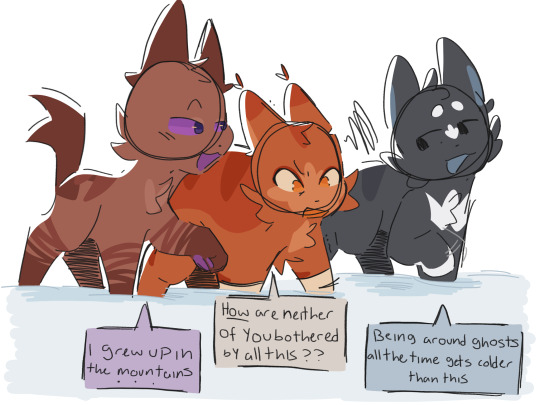

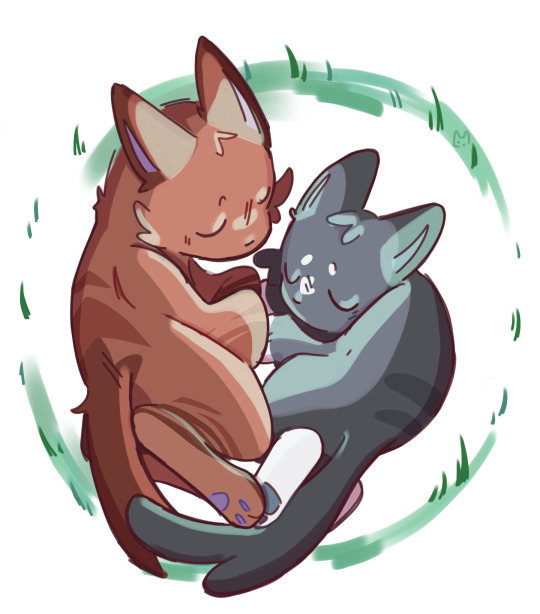
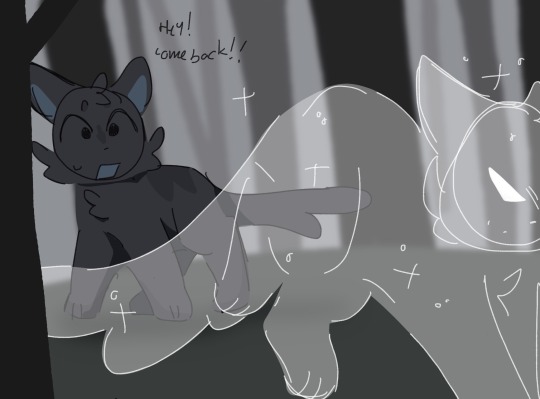

So like 4 people showed slight interest in my wcpdau so here you fellas go
Take my brainchild, which is less of a full proper story au and more like a series of doodles and various comics that have some vague common story
I’ll yap more about it under the cut :-)
Just general stuff, I can go in depth about it later but I’ll need reassurance that anyone gives a fuck beforehand
Right so as someone who’s had a cat special interest for practically my whole life, I had to find cat breeds that match the designs, lest I be too unrealistic (ignoring the very unnatural mouth/paw colors, I need whimsy in my life one way or another)
Dakota is a ginger American bobtail, Vynce/veer is a classic American shorthair brown tabby, will/whisper is a dark grey domestic longhair with slight vitiligo, and Ashe is a silver tabby longhair with white spotting :))
Slight spoilers for arc 2 of wc, since I imagine this is at the lake territory and vynce is from the tribe of rushing water
I only changed Vyncent and william’s names to fit their respective origins, since Dakota and Ashe are both from a lakeside town and they’re both already pretty good cat names
William was (is?) a shadowclan apprentice named whisperpaw, naturally, though they just call him whisper or wisp*
Vyncent is named Wolf who veers toward nest, though they just call him veer*
(Veer like Virion.. :-D)
*theres a little comic in my sketchbook about their names so if anyone gives a shit about that I’ll post it?ighess
It’s still hero adjacent, but instead of big superpower superhero type shit, think Pokémon mystery dungeon
#bandit's doodles#bandit’s words#adding the talking tag because good golly there’s enough words to fill a New York Times article#wcpdau#jrwi prime defenders#dakota cole#ashe winters#vyncent sol#william wisp#let’s goo#usually I have a zillion words in the tags but I already got most of my vocabulary out#thanks for caring about my little mental bug I call my wcpdau#hope this is interesting enough for you honey pies#xoxo#I was scared I lost my knack for drawing cats when I started learning to draw people#but it’s like muscle memory bro I couldn’t unlearn this if I tried#though drawing my fur/persona helps because they’re both cats#I also get to draw my little termite of a sona as wiwi’s little ghosts which is funny#anyways I’m gonna go skip into the sunset whimsically now
32 notes
·
View notes
Text

19 notes
·
View notes
Text
This is such an important article, the above link is a gift 🎁 link so that anyone can read the entire article, even if they don't subscribe to The New York Times. Here are some highlights:
Two prominent conservative law professors have concluded that Donald J. Trump is ineligible to be president under a provision of the Constitution that bars people who have engaged in an insurrection from holding government office. The professors are active members of the Federalist Society, the conservative legal group, and proponents of originalism, the method of interpretation that seeks to determine the Constitution’s original meaning. The professors — William Baude of the University of Chicago and Michael Stokes Paulsen of the University of St. Thomas — studied the question for more than a year and detailed their findings in a long article to be published next year in The University of Pennsylvania Law Review. [...] He summarized the article’s conclusion: “Donald Trump cannot be president — cannot run for president, cannot become president, cannot hold office — unless two-thirds of Congress decides to grant him amnesty for his conduct on Jan. 6.” [...] The provision in question is Section 3 of the 14th Amendment. Adopted after the Civil War, it bars those who had taken an oath “to support the Constitution of the United States” from holding office if they then “shall have engaged in insurrection or rebellion against the same, or given aid or comfort to the enemies thereof.” [...] The article concluded that essentially all of that evidence pointed in the same direction: “toward a broad understanding of what constitutes insurrection and rebellion and a remarkably, almost extraordinarily, broad understanding of what types of conduct constitute engaging in, assisting, or giving aid or comfort to such movements.” It added, “The bottom line is that Donald Trump both ‘engaged in’ ‘insurrection or rebellion’ and gave ‘aid or comfort’ to others engaging in such conduct, within the original meaning of those terms as employed in Section 3 of the 14th Amendment.” [...] The provision’s language is automatic, the article said, establishing a qualification for holding office no different in principle from the Constitution’s requirement that only people who are at least 35 years old are eligible to be president. “Section 3’s disqualification rule may and must be followed — applied, honored, obeyed, enforced, carried out — by anyone whose job it is to figure out whether someone is legally qualified to office,” the authors wrote. That includes election administrators, the article said. Professor Calabresi said those administrators must act. “Trump is ineligible to be on the ballot, and each of the 50 state secretaries of state has an obligation to print ballots without his name on them,” he said, adding that they may be sued for refusing to do so. [color/emphasis added]
Let's hope that election administrators across the US read this article and begin to set in motion the mechanism to prevent Donald Trump from appearing on ballots across the U.S., in case he does get the GOP nomination.
#trump#14th amendment section 3#trump cannot run for public office again#william baude#michael stokes paulsen#the new york times#gift article
344 notes
·
View notes
Text



Nicholas Galitzine for the New York Times
📷: Luisa Opalesky
141 notes
·
View notes
Text
This article came out about a week ago but it’s one of the coolest I’ve seen on the subject in a bit…
The manuscripts have 2 stories, one about Sir Gwaine, another focusing on Arthur, Guinevere, and Merlin in the court. The manuscript here was likely a “luxury item” for those familiar with Old French but “someone at Huntingfield Manor in Suffolk in the 16th century settled on the old parchment as a bit of raw material to strengthen a ledger” — likely because the value had depreciated after the stories were translated into English.
Some of the text was stitched into the binding or folded over so the people at Cambridge are using CT scans and multispectral imaging “to take hundreds of photographs of parts of the manuscript that were hidden”

Above is the main image of the manuscript from the Cambridge University Library, used in the header of the article.

And the manuscript after imaging… (also from the Cambridge University Library)
#genuinely this is so so incredible#im gonna throw up#like im sorry this is just so so cool#txt#article#arthuriana#new york times#cambridge library
13 notes
·
View notes
Note
Is there a background to the phrase Maybe we should know less about each other? Or did I just pick up that from you?
it's the title of an opinion column in the new york times about how people share too much of their lives on social media, and the phrase just works so well in so many contexts it's become a meme and i love it so much it's such a good one

#i'd link the article but first of all it's behind a paywall and secondly im not giving the new york times clicks#answered
50 notes
·
View notes